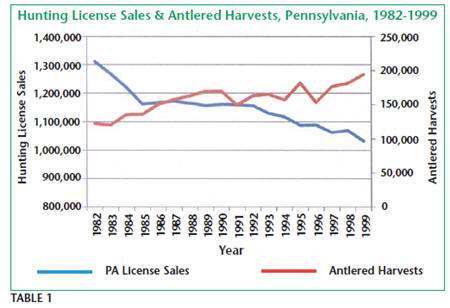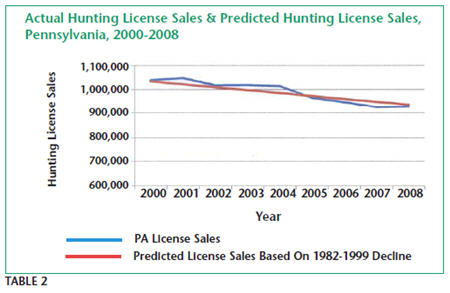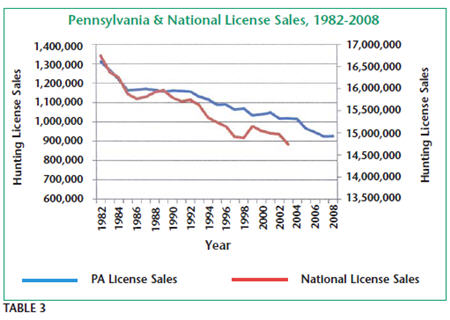Fewer Deer & Fewer Hunters: Are they Related?
By Dr. Chris Rosenberry
Deer & Elk Section Chief
As I was flipping through the pages of a national hunting magazine recently, I noticed a letter to the editor from a Pennsylvanian. In the letter, the author made it clear that, in his opinion, hunting license sales are down because the deer population is down.
He is not alone. No matter if one reads newspaper articles, letters to the editor, Internet message boards or even proposed legislation, recent changes in the deer program are regularly blamed for lower hunting license sales and fewer hunters.
But, do deer populations affect hunting license sales and hunter numbers? Can hunter participation be increased by allowing deer populations to increase?
Over the last decade, many changes have occurred in Pennsylvania's deer management program. In 2000, October antlerless seasons and concurrent antlered and antlerless firearm seasons began. New antler restrictions took effect in 2002. Wildlife Management Units came in 2003. From 2000 to 2004, antlerless allocations were at all-time highs. And, by 2005, deer populations across much of the state were smaller than they were five years before. License sales in 2005 also were less than they were in 2000. Given these factors, it would seem at least reasonable to blame deer management changes for fewer hunters.
Increasing deer populations and going back "to the way things used to be" are offered as ways to increase hunter numbers. History, however, tells a different story: There is no evidence that either of these solutions will increase license sales.
More Deer, More Licenses Sold?
The notion that more deer will result in more licenses sold sounds somewhat logical, but overstocked merchandise racks don't necessarily result in increased sales. From 1982 to 1999, deer populations, deer harvests and hunter success rates all increased, but hunting license sales declined. Let's take a closer look at what happened.
From 1982 to 1999, with similar seasons, antlered harvests increased from 122,000 to 194,000. And, the percent of hunters harvesting bucks more than doubled, from 9 percent in 1982 to 19 percent in 1999. Without a doubt, deer populations increased and hunter success increased.
During this same time period, however, hunting license sales went in the opposite direction. In 1982, more than 1.3 million hunters bought licenses. By 1999, about 1 million did — a loss of 300,000 hunters.
So, did more deer lead to more hunters? No. Declines in hunting license sales occurred despite increased deer populations and hunter success. See Table 1.
Concurrent Seasons, Antler Restrictions and WMUs: Making Matters Worse?

Although the idea that hunting license sales are directly related to deer abundance is not supported by historical data, some argue the concurrent firearms season, antler restrictions, Wildlife Management Units, and fewer deer are causing even more hunters to hang up their bows and guns. Is there any evidence that bears this out?
1999 was the last year of "the way things used to be" in deer hunting. In 1999, a 3-day antlerless season followed the traditional 2-week antlered-only season. Beginning in 2000, changes in hunting seasons and deer populations began.
While these various changes took place over the past eight years, hunting license sales continued to decline at a steady rate. Back in 1999, if someone had used information on hunter declines from 1982 to 1999 to forecast hunting licenses sales in 2008, they would have predicted sales of about 935,000. In reality, 926,000 hunting licenses were sold. What this indicates is that hunter numbers have decline at a steady and predictable rate for the last 28 years. Changes in the deer management program have not helped, or hurt, hunting license sales (Table 2).
If Not Deer, Then What?
If deer populations and management are not to blame, why are there fewer hunters today? Pennsylvania is not alone when it comes to declining license sales. Across the U.S., hunting license sales have been steadily declining since the early 1980s (Table 3). When surveyed, hunters most often identify personal reasons, such as lack of free time, family and work obligations, and limited access to hunting land as primary reasons for no longer hunting. Lack of game ranks well below these other factors.
In a survey of Pennsylvania hunters conducted by Responsive Management in 2004, more than a third of hunters cited personal health and age as the number one reason they did not plan to hunt in the future. The second reason was devoting more time to nonhunting activities. For eight percent of hunters, lack of game, including small game, was the main reason they quit hunting in Pennsylvania.
The Game Commission continues to address some of the reasons for declining hunting license sales and hunter numbers. Although the agency can do little about hunters' health and age, efforts to increase time for hunting and access to hunting land continue.
 Today, hunters have considerably more opportunities to hunt deer than in the past. Statewide, the archery season is six weeks long in the fall, with an additional two or three weeks after Christmas. As recently as 1991, it was only four weeks in the fall and two weeks after Christmas. Hunters today can hunt antlerless deer for a week in October with muzzleloaders. The rifle season is a 12-day concurrent season for antlered and antlerless deer in most of the state. In developed areas around Pittsburgh and Philadelphia, additional weeks are available to hunt deer with archery equipment and firearms.
Today, hunters have considerably more opportunities to hunt deer than in the past. Statewide, the archery season is six weeks long in the fall, with an additional two or three weeks after Christmas. As recently as 1991, it was only four weeks in the fall and two weeks after Christmas. Hunters today can hunt antlerless deer for a week in October with muzzleloaders. The rifle season is a 12-day concurrent season for antlered and antlerless deer in most of the state. In developed areas around Pittsburgh and Philadelphia, additional weeks are available to hunt deer with archery equipment and firearms.
The Game Commission continues to improve hunter access to land. There are more than 1.4 million acres of State Game Lands open to hunting. In addition, there are 3.6 million acres of private land open to public hunting in the Farm-Game, Safety Zone and Forest-Game programs. Add the nearly three million acres of other public land open to hunting, and Pennsylvania hunters have almost eight million acres, or 12,500 square miles, of land open to public hunting.
Although increasing deer populations or changing deer hunting seasons might sound like simple solutions, there is no evidence they would put an end to declining hunting license sales. The complex personal and social issues surrounding declining hunting license sales cannot be solved by having more deer in the woods.
From the December 2009 Pennsylvania Game News